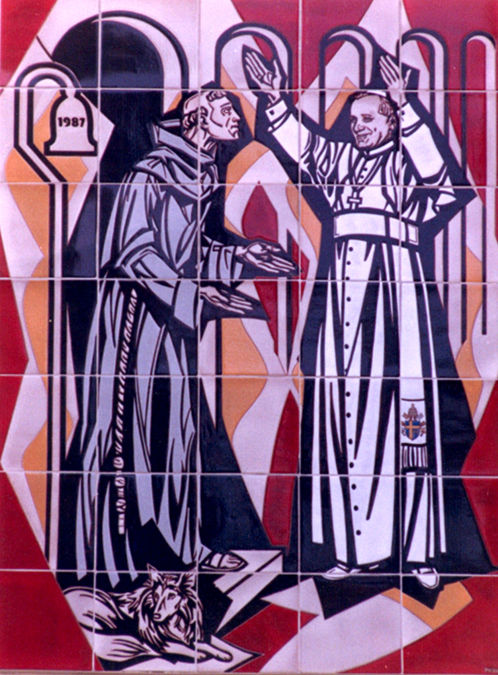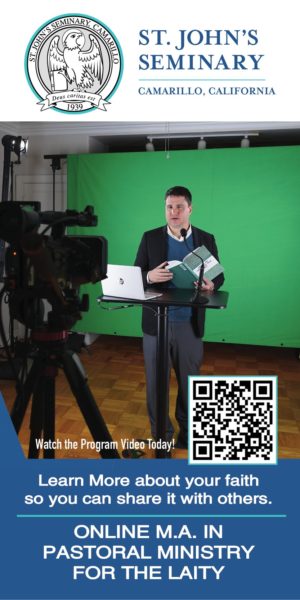If ever my diary or even parts of it are published, I suspect the most intriguing entry will be that made for September 16, 1987, the day Pope John Paul II dropped by for lunch.
At the outset, it should be pointed out that the Holy Father’s presence at what Time magazine called “the lovely San Fernando Mission,” was anything but a casual visit. A goodly portion of the preceding year was spent getting ready for what proved to be the most singular event in the almost 200-year history of California’s 17th missionary outpost.
And though one might fantasize that the Roman Pontiff came just to see “the best of the California missions,” or “the finest of the nation’s Catholic archives,” the real reason was to meet with members of the National Conference of Catholic Bishops during Pope John Paul’s second pastoral visit to the United States.
There were weekly and then daily briefings with members from the Papal Visit Office, the Secret Service, police and fire officials, traffic controllers, caterers, representatives from the United States Catholic Conference, media pools and other concerned agencies and individuals. San Fernando Mission became an integral part of the most elaborate and intensive preparations ever made for the visit of a foreign dignitary to the United States.
The already scheduled maintenance programs for the Old Mission were revised, updated and advanced in order to have the building, and grounds in top shape for the papal visit.
Las Damas Archivistas inaugurated plans for commemorating the event with appropriate splendor by commissioning the renowned artist, Isabel Piczek, to design and fabricate a giant tile portrayal of the Holy Father being welcomed to the Old Mission by Fray Junipero Serra. The ladies raised the necessary funds by sponsoring bake sales, boutiques and other service-related projects. Theirs became the most visible and surely the most colorful of all the preparations and involved the largest number of people.
On the eve of the Holy Father’s arrival, a gigantic “spit and shine” party was staged on the grounds. Forty-five volunteers brought brooms, rakes, dusters, clippers and bags to complete the final preparatory phase. Thousands of fallen leaves and flower buds were picked up, bagged and removed.
By mid-afternoon, the five acres comprising San Fernando Mission resembled a giant Hollywood movie set, except that ours was real. We prayed long and hard for good weather, and the Lord answered our supplications favorably.
A veritable army of Secret Service agents, police and fire personnel, Air Force bomb specialists, journalists, television crew and ecclesial officials began arriving at 2 a.m. on the targeted day of Sept. 16.
The entire area was “swept” by electronic sensors and then “sniffed out” by three specially-trained canines. That the security worked is confirmed by the fact that an “intruder” was indeed detected, discovered and placed in custody. The only mishap of the day occurred when an overly-zealous policeman accidentally set fire to a dry area of the adjoining property. Happily, the local incendiary squad reacted promptly and successfully.
A contingency of Las Damas Archivistas was processed through the command post at 6:30 a.m. and they quickly set about to complete preparations for feeding the bishops. About an hour later, the first episcopal contingency arrived from the New Otani Hotel.
The seven other buses bringing the cardinals, archbishops and bishops from the LAX Hilton rolled in on schedule at 7:45 a.m. Each of the prelates was greeted and then escorted to a staging area, where a continental breakfast was served by the colorfully costumed ladies.
At 8:45, the 305 members of the hierarchy were ushered to the mission church. The simple house of worship, decorated tastefully but simply by yellow and white gladiolas and tuberose lilies, symbolized the roots of the Church along the Pacific Slope. Towering over the assembled prelates was the stately figure of San Fernando Rey de Espana, the same statue that presided over the establishment of the mission in 1797.
“Marine #1,” the helicopter bringing the Holy Father from Saint Vibiana’s Cathedral, arrived precisely at 9:05 a.m., landing on the field of Queen of Angels Seminary. Three additional khaki-colored helicopters transported the rest of the papal party.
After His Holiness had been officially welcomed to “Mission Hills International,” he entered a limousine with Archbishop Roger Mahony for a short motorcade around the western perimeter of the seminary to the gate leading into the mission cemetery. During his short walk towards the Church, the Holy Father blessed the graves of the almost 1,200 Indians interred there between 1797 and 1840.
As he approached the church, the Holy Father glanced upward at the magnificent tile portrayal commemorating his visit. The smile that came across his face was likely inspired by the depiction of the little Sheltie doggie, smallPAXweber, which sits ever-so-quietly at the feet of Fray Junipero Serra.
At the entrance to the church, the Holy Father was presented with an artistically embroidered stole. He blessed himself and his party with holy water and then entered the church where he was greeted by applause from the assemblage.
Lauds or Morning Prayer was sung and recited by the Pontiff and the American hierarchy. In his homily, Pope John Paul II exhorted the bishops to “be examples to the flock,” saying that “we shall be precisely that to the extent that our lives are centered on the person of Jesus Christ.”
At the completion of Lauds, Archbishop Mahony, acting on behalf of the local Catholic community, presented the Holy Father with a beautiful oil painting of the Old Mission together with the historical concordance entrusted to Fray Junipero Serra by his Mallorcan confreres in 1749.
Afterwards, the Pontiff was led through the mission gardens to the seminary dining hall where he was officially welcomed by the cardinals, archbishops and bishops of the United States. In what Time described as “an exceptionally cordial encounter,” Pope John Paul II listened intently to several interventions by representatives of the episcopacy, and then engaged in a dialogue that lasted well beyond the allotted time. Details of that meeting were divulged through official channels.
Following a short pause in the Old Mission’s rectory, the Holy Father returned for a buffet luncheon in the garden area. About an hour later he rose, thanked the episcopal conference, and went back to the rectory for a brief rest. It was exactly 2:30 when “Marine # 1,” lifted majestically into the sky.
As requested, the Holy Father left behind his signature in our guest book, on an autograph card and on a white zucchetto. In addition he presented a chasuble and stole with a papal crest to the Historical Museum, together with a small box of rosaries and medals “for your dear friends.”
It took several days for those of us here at San Fernando Mission to digest the happenings of those five and a half hours — to fully appreciate that Pope John Paul II had prayed in our church, lunched in our garden and rested in our quarters. Hereafter and forever, San Fernando will be the “papal mission,” the first of those great frontier establishments along the Pacific Slope, visited by the Vicar of Christ.
Msgr. Francis J. Weber, archivist emeritus for the Archdiocese of Los Angeles, has been for many years administrator of San Fernando Mission, Mission Hills.

